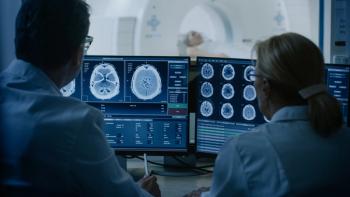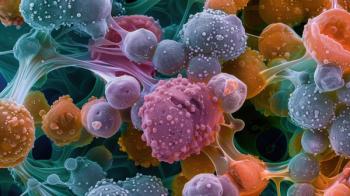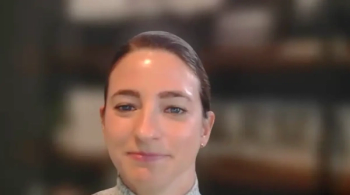
Expert Insights on Key Data from IMS 2025
Key Takeaways
- Teclistamab-based regimens in NDMM achieved 100% ORR and MRD negativity, indicating strong efficacy in early therapy lines.
- The study raises questions about the optimal duration of BCMA T-cell engagers and the contribution of bortezomib.
Expert shares notable findings presented at the 2025 IMS Annual Meeting.
OA-13 Post-Induction Outcomes and Updated Minimal Residual Disease Analysis from GMMG-HD10/ DSMM-XX (MajesTEC-5): A Study of Teclistamab- Based Induction Regimens in Newly Diagnosed Multiple Myeloma
BCMA T-cell engagers (TCEs) are being evaluated in earlier lines of therapy for the management of multiple myeloma (MM). In the phase 2 MajesTEC-5 trial (NCT05695508)1, teclistamab (Tec, Tecvayli; Janssen Biotech, Inc) combinations are being assessed in patients with transplant-eligible newly diagnosed MM (NDMM)2:
- Arm A: Tec administered weekly with daratumumab (Darzalex; Janssen) and lenalidomide (Revlimid; Bristol Myers Squibb)
- Arm A1: Tec every 4 weeks with daratumumab and lenalidomide
- Arm B: Tec every 4 weeks with daratumumab, bortezomib, and lenalidomide
The updated data presented at the International Myeloma Society Annual Meeting involved 49 patients who had received treatment (Arm A, Tec [QW]-DR, n = 10; Arm A1, Tec [every 4 weeks]-DR, n = 20; Arm B, Tec [every 4 weeks]-DVR, n = 19) with a median follow-up of 7.0 (2.5–13.2) months. The regimen demonstrated a grade 3/4 treatment emergent adverse event (TEAEs) incidence of 89.8%, a grade 3/4 infection incidence of 34.7%, and serious treatment emergent AEs incidence of 53.1%.2
CRS occurred in 65.3% of pts (grade 1, 44.9%; grade 2, 20.4%) with no cases of Immune effector cell-associated neurotoxicity syndrome (ICANS) observed. No TEAEs led to discontinuation of full study treatment discontinuation or death.2
After induction, the ORR was 100% in all arms. For the 46 minimal residual disease (MRD)-evaluable patients with available samples after cycle 3 the MRD negativity rate at 10-5 was 100%, and for these patients, after cycle 6 the MRD negativity rate at 10-5 and 10-6 were 100%. All except one pt had successful stem cell mobilization.2
These impressive MRD responses after induction pose questions on the optimal duration of a BCMA T-cell engager for transplant-eligible patients with NDMM. For instance, the goal could be 3 years of sustained MRD negativity with negative PET/CT findings—and, based on the data presented, it’s worth asking what additional benefit bortezomib is contributing.
These data are important to take along with those anticipated from the phase 3 trials MajesTEC‑4 (NCT05243797)3 and MajesTEC‑7 (NCT05552222),4 as well as the phase 2 trials evaluating Tec-based combinations in the frontline setting.
- MajesTEC-4: evaluating Tec + lenalidomide versus lenalidomide alone (versus Tec alone) as maintenance therapy following autologous stem cell transplantation in patients with NDMM
- MajesTEC-7: evaluating Tec-DR in patients with NDMM ineligible for or not intended to receive autologous stem cell transplantation
OA-57 IVIG and Longer Dosing Intervals Reduce Risk of Infections in Patients with RRMM Treated with Tec
The recent update to the National Comprehensive Cancer Network Multiple Myeloma guidelines recommends primary prophylaxis with immunoglobulin (IgG) supplementation for patients with MM receiving T-cell engagers regardless of IgG levels. It is an important supportive care consideration going forward especially with TCEs anticipated move into earlier lines of therapy.5
This abstract from Smits et al, which evaluated the infection rates based on Ig prophylaxis (primary versus secondary) and dosing interval for patients with relapsed/refractory MM (RRMM) receiving Tec, continues to emphasize not only the benefit of primary Ig prophylaxis in decreasing the risk for severe infections, but also that lengthening of the dosing interval of TCEs.5
Although current recommendations inform the practice of primary prophylaxis with Ig repletion (e.g. 0.4 g/kg IV every 4 weeks starting with cycle 2 day 1), there remains questions on optimal dose, schedule, and timing as well as factors to guide discontinuation of Ig repletion, which are elegantly highlighted in an article by Banerjee et al.5,6
Interestingly, the administration of Ig repletion may influence the pharmacokinetics of monoclonal antibodies by saturating neonatal Fc receptors, which function to recycle endogenous and therapeutic antibodies that are administered, potentially decreasing the half-life of administered therapeutic antibodies. This relationship requires further study in the context of better understanding the optimal dosing for TCE-containing regimens and Ig repletion.
PA-011 Absolute Lymphocyte Count as a Key Biomarker for Monitoring Safety After Ciltacabtagene Autoleucel
A number of real-world experiences have detailed the association between peak absolute lymphocyte counts (ALC) post-ciltacabtagene autoleucel (cilta-cel, Carvykti; Janssen Biotech, Inc) and neurotoxicity, as well as the potential for intervening with, for example, a pre-emptive short course of dexamethasone for patients with a peak ALC above a certain threshold (Turner et al; OA-05; PA-099; PA-042; PA-026).7-12
This analysis which serves as an accompaniment by presenting data from CARTITUDE-1 (NCT03548207),13 CARTITUDE-2 (NCT04133636),14 and CARTITUDE-4 (NCT04181827)15 provides information on biomarkers associated with neurotoxicity risks after cilta-cel in patients with multiple myeloma. Elevated ALC and chimeric antigen receptor (CAR) T-cell expansion within 14 days post-CAR-T infusion emerge as strong early predictors of movement and neurocognitive toxicities (MNT) and cranial nerve palsy (CNP).7
These findings highlight ALC as a biomarker for early identification of patients at risk for MNT/CNP and the importance of integrating ALC monitoring to guide proactive interventions such as corticosteroids to mitigate severe neurologic events.
PA-017 Bispecific Outpatient Step-Up Dosing with Prophylactic Dexamethasone: The BOSS Program Experience in Myeloma
There is a continued focus and effort to improve accessibility of TCEs for patients with MM, especially in community oncology settings. While approaches utilizing tocilizumab (Actemra; Genentech) as cytokine release syndrome (CRS) prophylaxis are being adopted, an alternative strategy is utilizing post-treatment dexamethasone for CRS prophylaxis and identifying patients more suitable for outpatient step-up dosing and monitoring.16
This experience describes a bispecific antibody outpatient step-up dosing program, which included patients who received elranatamab (Elrexfio; Pfizer), Tec, and talquetamab (Talvey; Janssen Biotech), that utilizes dexamethasone 12 mg on select days post-treatment and daily telehealth visits to assess symptoms.16
Of the 112 patients who received step-up dosing and first treatment dose, 15 patients and 97 patients received step-up dosing and monitoring as an outpatient and inpatient, respectively. The incidence of CRS was observed in 13.3% of patients treated as an outpatient, while CRS was observed in 53.6% of patients treated as an inpatient.16
Of the patients treated as an outpatient, 87% (n = 13/15) avoided hospitalization and 2 patients were admitted for grade 2 CRS. This experience emphasizes that outpatient step-up dosing and monitoring for patients with multiple myeloma receiving TCEs are feasible and can reduce barriers to access and lower healthcare costs.16
OA-68 Safety and Efficacy of Linvoseltamab (LINVO) in Patients (Pts) with High-risk Smoldering Multiple Myeloma (HR-SMM): First Results from the Phase 2 LINKER-SMM1 Trial
With the positive FDA ODAC vote on the benefit-risk profile of daratumumab for patients with high-risk smoldering MM (HR-SMM) based on the AQUILA trial (NCT03301220), which demonstrated an improved overall survival (OS) with a 60-month OS rate of 93.0% vs 86.9% (HR = 0.52; 95% CI = 0.27–0.98) with subcutaneous (SC) daratumumab monotherapy for 3 years compared with active monitoring.17,18
There is growing attention on developing therapeutic strategies for patients with HR-SMM that range in therapeutic intensity aiming for either disease control or disease cure. Linvoseltamab (Lynozyfic; Regeneron), a BCMA x CD3 bispecific antibody, as monotherapy is being investigated in patients with HR-SMM in the phase 2 LINKER-SMM1 trial (NCT05955508; HR-SMM defined as a diagnosis of SMM within 5 years of study entry and high-risk per the Mayo 2018 “20-2-20” or PETHEMA [Spanish Cooperative Group] criteria). Linvoseltamab was administered for approximately 2 years.17,19
Linvoseltamab demonstrated a manageable safety profile predominantly notably for neutropenia and infection, and primarily low-grade CRS events. An overall response rate (ORR) of 100% has been reported (≥very good partial response [VGPR] 74%; ≥complete response [CR] 37%) and notably for patients enrolled on the phase 1 portion with longer follow-up, all have achieved greater than or equal to VGPR (1 VGPR; 5 ≥CR) and 100% achieved MRD negativity at 10−6.17
As trials continue to mature evaluating TCE monotherapy, TCE-based combinations, CAR T-cell therapies, and more familiar anti-CD38 based doublets, triplets, and quadruplets for patients with high risk smoldering multiple myeloma, there will continue to be an emphasis on patient selection and weighing the benefit/risk profile for these approaches in this patient population. Importantly, there will be an expanding role for oncology pharmacists to ensure that supportive care is tailored for individual patient needs.17
OA-61 A Randomized Phase 2 Study of Daratumumab, Lenalidomide, Ixazomib, and Dexamethasone in Transplant-Ineligible/Deferred Patients with Newly Diagnosed Multiple Myeloma: Alliance Foundation Trial 41
Recent data from the CEPHEUS (NCT03652064),20 IMROZ (NCT03319667),21 and BENEFIT (NCT04751877)22 trials support the recommendation for anti-CD38 monoclonal antibodies in combination with bortezomib, lenalidomide, and dexamethasone (VRd) as first-line treatment for transplant ineligible patients with NDMM.
However, although modifications were made for tolerability in the BENEFIT trial, there still remains a need in understanding in how to optimally dose attenuate for tolerability while maintaining treatment efficacy, in particular in patients who are frail.23
Building upon the VRd-lite regimen, the phase 2 AFT-41 trial (NCT04009109)24 evaluated the quadruplet, daratumumab plus lenalidomide, ixazomib (Ninlaro; Takeda Pharmaceutical Company Limited), and dexamethasone (Dara-RId) for transplant-ineligible or deferred patients with NDMM.23
Patients received 12 cycles (28-day cycles) with daratumumab 1800 mg SC on the conventional schedule, lenalidomide 15 mg orally (PO) on days 1 through 21, ixazomib 4 mg PO on days 1, 8, 15, and dexamethasone weekly. After 12 cycles, patients received maintenance with either Dara-RI or R for up to 2 years based on randomization that occurred at enrollment. In maintenance, lenalidomide was reduced to 10 mg and ixazomib was reduced to 3 mg.23
In an older patient population, Dara-RId demonstrated a 12-month PFS of 92% and an ORR during induction of 92.4% with a manageable safety profile and notably no grade 3 or greater neuropathy reported (grade 1, 15%; grade 2, 14%). These impressive data in a frail patient population that with early follow-up is comparable to other trials evaluating CD38-based quadruplet regimens demonstrate the importance of tailoring drug dosing and the role of ixazomib for these patients.23
REFERENCES
1. GMMG-HD10 / DSMM-XX / 64007957MMY2003, MajesTEC-5 (HD10/DSMMXX). Clinicaltrials.gov. Updated October 23, 2025. Accessed October 27, 2025. https://clinicaltrials.gov/study/NCT05695508?utm_source=chatgpt.com
2. Raab M, Weinhold N, Kortüm KM, et al. post-induction outcomes and updated minimal residual disease analysis from GMMG-HD10/ DSMM-XX (MajesTEC-5): a study of teclistamab-based induction regimens in newly diagnosed multiple myeloma (NDMM). Presented at: 2025 International Myeloma Society 22nd Annual Meeting. September 17, 2025, to September 20, 2025. Toronto, Canada. Abstract OA-13.
3. Phase 3 study of teclistamab in combination with lenalidomide and teclistamab alone versus lenalidomide alone in participants with newly diagnosed multiple myeloma as maintenance therapy following autologous stem cell transplantation (MajesTEC-4). Clinicaltrials.gov. Updated October 1, 2025. Accessed October 27, 2025. https://clinicaltrials.gov/study/NCT05243797?utm_source=chatgpt.com
4. A study of teclistamab in combination with daratumumab and lenalidomide (Tec-DR) and talquetamab in combination with daratumumab and lenalidomide (Tal-DR) in participants with newly diagnosed multiple myeloma (MajesTEC-7). Clinicaltrials.gov. Updated September 12, 2025. Accessed October 27, 2025. https://clinicaltrials.gov/study/NCT05552222
5. Smits F, Groen K, Korst C, et al. IVIG and longer dosing intervals reduce risk of infections in patients with RRMM treated with teclistamab. Presented at: 2025 International Myeloma Society 22nd Annual Meeting. September 17, 2025, to September 20, 2025. Toronto, Canada. Abstract OA-57.
6. Banerjee R, Mohan M, Rejeski K, et al. Immunoglobulin prophylaxis should be initiated after bispecific antibody therapy in multiple myeloma, regardless of IgG levels. Blood Adv. September 23, 2025. doi:10.1182/bloodadvances.2025016490
7. LinY, Montest de Oca R, Dhakal B, et al. Absolute lymphocyte count as a key biomarker for monitoring safety after ciltacabtagene autoleucel. Presented at: 2025 International Myeloma Society 22nd Annual Meeting. September 17, 2025, to September 20, 2025. Toronto, Canada. Abstract PA-011
8. Turner J, Forsberg P, Nicholson S, et al. Prophylactic dexamethasone rescues unrestrained lymphocyte expansion in anti-BCMA chimeric antigen receptor T cell therapy in multiple myeloma. American Society for Transplantation and Cellular Therapy. February 2025. doi: 10.1016/j.jtct.2025.01.330
9. Hosoya H, Velayati A, Dima D, et al. Rapid peak CAR-T expansion is associated with delayed neurotoxicity following ciltacabtagene autoleucel in multiple myeloma. Presented at: 2025 International Myeloma Society Annual Meeting. September 17, 2025, to September 20, 2025. Toronto, Canada. Abstract OA-05
10. Varshavsky Yanovsky A, Shestovska Y, Michael S, et al. High ALC peak post cilta-cel infusion predicts risk for delayed neurological toxicities. Presented at: 2025 International Myeloma Society Annual Meeting. September 17, 2025, to September 20, 2025. Toronto, Canada. Abstract PA-099
11. Eric Jurgens1, Sneha Mitra1, David Nemirovsky, et al. Peak absolute lymphocyte count as a biomarker for CAR T-cell expansion is associated with nonICANS neurotoxicities following ciltacabtagene autoleuecel. Presented at: 2025 International Myeloma Society Annual Meeting. September 17, 2025, to September 20, 2025. Toronto, Canada. Abstract PA-042
12. Feliciano Salva K, Copponex C, Whiting J, et al. Evaluation of sequential absolute lymphocyte count (ALC) in patients with relapsed multiple myeloma (RRMM) with cranial nerve palsies (CNPs) post ciltacabtagene-autoleucel (cilta-cel). Presented at: 2025 International Myeloma Society Annual Meeting. September 17, 2025, to September 20, 2025. Toronto, Canada. Abstract PA-026
13. A study of JNJ-68284528, a chimeric antigen receptor T cell (CAR-T) therapy directed against B-cell maturation antigen (BCMA) in participants with relapsed or refractory multiple myeloma (CARTITUDE-1). Updated July 30, 2025. Accessed October 27, 2025. https://www.clinicaltrials.gov/study/NCT03548207#study-overview
14. A study of JNJ-68284528, a chimeric antigen receptor T cell (CAR-T) therapy directed against B-cell maturation antigen (BCMA) in participants with multiple myeloma (CARTITUDE-2). Clinicaltrials.gov. Updated October 10, 2025. Accessed October 27, 2025. https://clinicaltrials.gov/study/NCT04133636
15. A study comparing JNJ-68284528, a CAR-T therapy directed against B-cell maturation antigen (BCMA), versus pomalidomide, bortezomib and dexamethasone (PVd) or daratumumab, pomalidomide and dexamethasone (DPd) in participants with relapsed and lenalidomide-refractory multiple myeloma (CARTITUDE-4). Clinicaltrials.gov. Updated October 17, 2025. Accessed October 27, 2205. https://www.clinicaltrials.gov/study/NCT04181827
16. Cirstea D, E. Kim B, O’Neill S, et al. Bispecific outpatient step-up dosing with prophylactic dexamethasone: The BOSS program experience in myeloma. Presented at: 2025 International Myeloma Society Annual Meeting; September 17-20, 2025; Toronto, Canada. Abstract PA-017
17. Rodríguez-Otero P, Lleonart J, Clavero ME, et al. Safety and efficacy of linvoseltamab (LINVO) in patients (Pts) with high-risk smoldering multiple myeloma (HR-SMM): First results from the phase 2 LINKER-SMM1 trial. Presented at: 2025 International Myeloma Society Annual Meeting; September 17-20, 2025; Toronto, Canada. Abstract OA-68
18. A study of subcutaneous daratumumab versus active monitoring in participants with high-risk smoldering multiple myeloma. Updated October 10, 2025. Accessed October 27, 2025. https://clinicaltrials.gov/study/NCT03301220
19. A proof-of-concept trial to study the safety and activity of linvoseltamab in participants with smoldering multiple myeloma at high risk of developing multiple myeloma. Clinicaltrials.gov. Updated September 4, 2025. Accessed October 27, 2025. https://clinicaltrials.gov/study/NCT05955508
20. A study comparing daratumumab, VELCADE (bortezomib), lenalidomide, and dexamethasone (D-VRd) With VELCADE, lenalidomide, and dexamethasone (VRd) in participants with untreated multiple myeloma and for whom hematopoietic stem cell transplant is not planned as initial therapy. Clinicaltrials.gov. Updated October 10, 2025. Accessed October 27, 2025. https://clinicaltrials.gov/study/NCT03652064
21. A study to investigate the clinical benefit of isatuximab in combination with bortezomib, lenalidomide and dexamethasone in adults with newly diagnosed multiple myeloma not eligible for transplant (IMROZ). Clinicaltrials.gov. Updated November 26, 2024. Accessed October 27, 2025. https://clinicaltrials.gov/study/NCT03319667
22. Multicenter open label phase 3 study of isatuximab plus lenalidomide and dexamethasone with/without bortezomib in the treatment of newly diagnosed non frail transplant ineligible multiple myeloma elderly patients (≥ 65; < 80 Years). Clinicaltrials.gov. Updated September 7, 2022. Accessed October 27, 2025. https://clinicaltrials.gov/study/NCT04751877
23. Yee A, O’Donnell E, Nadeem O, et al. A randomized phase 2 study of daratumumab, lenalidomide, ixazomib, and dexamethasone in transplant-ineligible/deferred patients with newly diagnosed multiple myeloma: alliance foundation trial 41. Presented at: 2025 International Myeloma Society Annual Meeting; September 17-20, 2025; Toronto, Canada. Abstract OA-61
24. Study of lenalidomide/ixazomib/dexamethasone/daratumumab in transplant-ineligible patients with newly diagnosed MM. Clinicaltrials.gov. Updated April 25, 2025. Accessed October 27, 2025. https://clinicaltrials.gov/study/NCT04009109
Newsletter
Stay informed on drug updates, treatment guidelines, and pharmacy practice trends—subscribe to Pharmacy Times for weekly clinical insights.


















































































































































































































